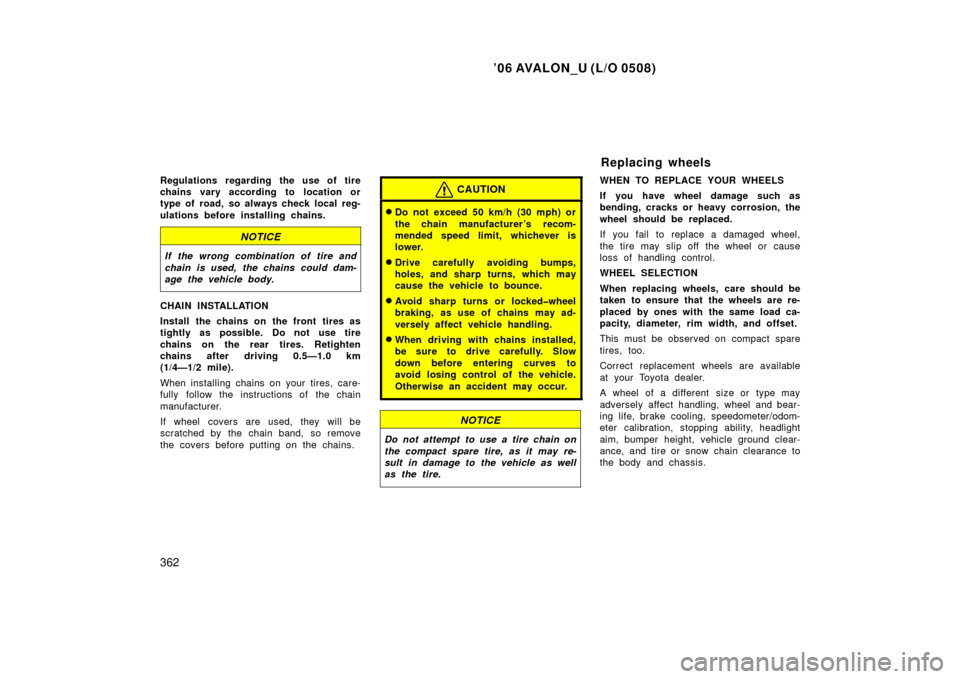Page 283 of 398
’06 AVALON_U (L/O 0508)
275
This illustration indicates typical tire
symbols.
1. “TEMPORARY USE ONLY”— A
compact spare tire is identified by
the phrase “TEMPORARY USE
ONLY” molded into its sidewall.
This tire is designed for temporary
emergency use only. For details,
see “Compact spare tire” on page
315.
2. Tire size— F or det ails, see “— Ti re
size” on page 277.
3. DOT and Tire Identification Number (TIN)— For details, see
“—DOT and Tire Identification
Number (TIN)” on page 276.
4. The location of the tread wear indicators— For details, see
“Checking and replacing tires” on
page 357.
5. Load limit at maximum cold tire inflation pressure— For details,
see “Checking and replacing tires”
on page 357.
—Tire symbols (compact spare tire)
Page 324 of 398
’06 AVALON_U (L/O 0508)
316
1. Get the required tools andspare tire.
1. Jack handle
2. Wheel nut wrench
3. Jack
4. Spare tire
To prepare yourself for an emergency,
you should familiarize yourself with
the use of the jack, each of the tools
and their storage locations.To remove the jack, turn the jack joint
by hand until the jack becomes free.To st or e the jac k , align the hole o f t he
jack head with the vehicle hook. Turn
the jack joint until the jack base fits
securely with the vehicle body.
This prevents the jack from flying for-
ward during a collision or sudden
stop.
—Required tools and spare
tire
Page 330 of 398

’06 AVALON_U (L/O 0508)
322
CAUTION
�Take due care in handling the
ornament to avoid unexpected
personal injury.
� Do not attach a heavily dam-
aged plastic wheel ornament.
It may fly off the wheel and
cause accidents while the ve-
hicle is moving.
11. Check the air pressure of the re-
placed tire.
Adjust the air pressu re to the specifi-
cation designated on page 380 in
Section 8. If the pressure is lower,
drive slowly to the nearest service
station and fill to the correct pressure.
Do not forget to reinstall the tire infla-
tion valve cap as dirt and moisture
could get into th e valve core and
possibly cause air leakage. If the cap
is missing, have a new one put on as
soon as possible.
12.Restow all the tools, jack and flat tire securely.
As soon after changing wheels as
possible, tighten the wheel nuts to the
torque specified on page 380 in Sec-
tion 8 with a torque wrench. Have a
technician repair the flat tire and re-
place the spare tire with it.CAUTION
Before driving, make sure all the
tools, jack and flat tire are se-
curely in place in their storage
location to reduce the possibility
of personal injury during a colli-
sion or sudden braking.
—After changing wheels
Page 366 of 398

’06 AVALON_U (L/O 0508)
358 The tires on your Toyota have built−in
tread wear indicators to help you
know when the tires need replace-
ment. When the tread depth wears to
1.6 mm (0.06 in.) or less, the indica-
tors will appear. If you can see the
indicators in two or more adjacent
grooves, the tire should be replaced.
The lower the tread, the higher the
risk of skidding.
The effectiveness of snow tires is
lost if the tread wears down below
4 mm (0.16 in.).
If you have tire damage such as
cuts, splits, cracks deep e nough to
expose the fabric, or bulges indi-
cating internal damage, the tire
should be repl aced.
If a tire often goes flat or cannot be
properly repaired due to the size or
location of a cut or other damage, it
should be replaced. If you are not
sure, consult with your Toyota dealer. If air loss occurs while driving, do not
continue driving. Driving even a short
distance can damage a tire beyond
repair.
An y ti res wh i ch are over 6 years
old must be checked by a qualified
technician even if damage is not
obvious.
Tires deteriorate with age even if they
have never or seldom been used.
This applies also to the spare tire and
tires stored for future use.
REPLACING YOUR TIRES
When replacing a tire, use a tire of
the same size and construction,
and the same or greater maximum
load as the originally installed
tires.
Using any other size or type of tire
may seriously affect handling, ride,
speedometer/odometer calibration,
ground clearance, and clearance be-
tween the body and tires or snow
chains.
Check that the maximum load of the
replaced tire is greater than 1/2 of the
Gross Axle Weight Ratings (GAWR)
of either the front axle or the rear
axle, whichever is greater. As for the
maximum load of the tire, see the load
limit at maximum cold tire inflation
pressure mentioned on the sidewall
of the tire, and as for the Gross Axle
Weight Ratings (GAWR), see the Cer-
tification Label.
For details about the side wall of the
tire and the Certification Label, see
pages 271 and 273.
Page 370 of 398

’06 AVALON_U (L/O 0508)
362
Regulations regarding the use of tire
chains vary according to location or
type of road, so always check local reg-
ulations before installing chains.
NOTICE
If the wrong combination of tire and
chain is used, the chains could dam-
age the vehicle body.
CHAIN INSTALLATION
Install the chains on the front tires as
tightly as possible. Do not use tire
chains on the rear tires. Retighten
chains after driving 0.5—1.0 km
(1/4—1/2 mile).
When installing chains on your tires, care-
fully follow the instructions of the chain
manufacturer.
If wheel covers are used, they will be
scratched by the chain band, so remove
the covers before putting on the chains.
CAUTION
�Do not exceed 50 km/h (30 mph) or
the chain manufacturer ’s recom-
mended speed limit, whichever is
lower.
�Drive carefully avoiding bumps,
holes, and sharp turns, which may
cause the vehicle to bounce.
�Avoid sharp turns or locked�wheel
braking, as use of chains may ad-
versely affect vehicle handling.
�When driving with chains installed,
be sure to drive carefully. Slow
down before entering curves to
avoid losing control of the vehicle.
Otherwise an accident may occur.
NOTICE
Do not attempt to use a tire chain on
the compact spare tire, as it may re-
sult in damage to the vehicle as well
as the tire.
WHEN TO REPLACE YOUR WHEELS
If you have wheel damage such as
bending, cracks or heavy corrosion, the
wheel should be replaced.
If you fail to replace a damaged wheel,
the tire may slip off the wheel or cause
loss of handling control.
WHEEL SELECTION
When replacing wheels, care should be
taken to ensure that the wheels are re-
placed by ones with the same load ca-
pacity, diameter, rim width, and offset.
This must be observed on compact spare
tires, too.
Correct replacement wheels are available
at your Toyota dealer.
A wheel of a different size or type may
adversely affect handling, wheel and bear-
ing life, brake cooling, speedometer/odom-
eter calibration, stopping ability, headlight
aim, bumper height, vehicle ground clear-
ance, and tire or snow chain clearance to
the body and chassis.
Replacing wheels